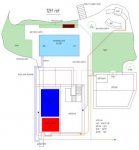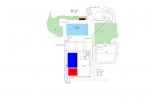Hello. As I announced in my introduction to the forum, I am thinking to build a swimming pool in my property. It is going to be part of a complete remodel of my backyard; I will also build an outdoors kitchen and, later, a detached garage.
I am trying to read up as much as possible because my experience in remodeling and work in general is:
- speed of execution
- quality of execution
- costs
You can only take two or less. And I put quality as the most important characteristic. I want something that will last decades, it does not matter if it's going to cost more or take few years to be built. Surely I would not mind having the pool by the end of 2018 but not if I have to compromise on quality and cleanliness of execution!
Also, while I prize the best materials and "over - engineering" through the project, I do not mind saving by doing some of the work myself especially in the "research" phase, that means fully understanding what is going on and checking that thing are done well the first time.
I have a extremely good relationship with a contractor that so far has acted both as GC and doing a good part of the work; he does not have specific competence in building pools but he surely can do the prep work, excavation, trenching etc. I love to go down to the city hall, so far (unrelated to the pool) the guys in planning and building have been fantastic with a lot of good advice.
--- === === === ---
Now, after the lengthy introduction, I will start asking a bunch or random questions. It's part of my mental process to start deciding what to do and how to articulate the work. You will see they are pretty "random" but I am trying to start connecting the dots before I decide to start with this project.
1) the water we receive from the city comes from Hetch Hetchy. It is generally considered a good quality water, except for baking (one of my hobbies), as it has a very low calcium content, my measurements show 3 to 5 F (French degrees) that should be 30 to 50 ppm. Does this have any implication in swimming pool chemistry?
2) I have been studying the plumbing of a swimming pool as it's one of the most important steps for my planning - I need to trench to deliver utilities to the outdoors kitchen and the garage, and to provide proper drainage to the backyard, and I want the pool to fit nicely into this. So far I've read things and the opposite of things:
a) is there a good, definitive guide to swimming pool plumbing best practices?
b) should skimmers and drains be connected to the same pipes?
c) should the return lines be on top or on the bottom?
3) I do not want fences and gates around the pool. It will just not happen. Can an automated cover system be used in place of gates and fences? My kids are trained to survive when thrown in a body of water but apparently local governments mandate to protect the well-being of trespassers.


4) Is a half inch copper water line enough for the needs of a pool? I need to run one on that side of the house and I would like to do the job only once.
Thank you!
I am trying to read up as much as possible because my experience in remodeling and work in general is:
- speed of execution
- quality of execution
- costs
You can only take two or less. And I put quality as the most important characteristic. I want something that will last decades, it does not matter if it's going to cost more or take few years to be built. Surely I would not mind having the pool by the end of 2018 but not if I have to compromise on quality and cleanliness of execution!
Also, while I prize the best materials and "over - engineering" through the project, I do not mind saving by doing some of the work myself especially in the "research" phase, that means fully understanding what is going on and checking that thing are done well the first time.
I have a extremely good relationship with a contractor that so far has acted both as GC and doing a good part of the work; he does not have specific competence in building pools but he surely can do the prep work, excavation, trenching etc. I love to go down to the city hall, so far (unrelated to the pool) the guys in planning and building have been fantastic with a lot of good advice.
--- === === === ---
Now, after the lengthy introduction, I will start asking a bunch or random questions. It's part of my mental process to start deciding what to do and how to articulate the work. You will see they are pretty "random" but I am trying to start connecting the dots before I decide to start with this project.
1) the water we receive from the city comes from Hetch Hetchy. It is generally considered a good quality water, except for baking (one of my hobbies), as it has a very low calcium content, my measurements show 3 to 5 F (French degrees) that should be 30 to 50 ppm. Does this have any implication in swimming pool chemistry?
2) I have been studying the plumbing of a swimming pool as it's one of the most important steps for my planning - I need to trench to deliver utilities to the outdoors kitchen and the garage, and to provide proper drainage to the backyard, and I want the pool to fit nicely into this. So far I've read things and the opposite of things:
a) is there a good, definitive guide to swimming pool plumbing best practices?
b) should skimmers and drains be connected to the same pipes?
c) should the return lines be on top or on the bottom?
3) I do not want fences and gates around the pool. It will just not happen. Can an automated cover system be used in place of gates and fences? My kids are trained to survive when thrown in a body of water but apparently local governments mandate to protect the well-being of trespassers.
4) Is a half inch copper water line enough for the needs of a pool? I need to run one on that side of the house and I would like to do the job only once.
Thank you!


 Welcome to TFP!!!
Welcome to TFP!!!
